Quick Summary:
In an era where logistics, transportation, and supply chain networks are becoming increasingly complex and customer expectations are at an all-time high, AI-powered Assistants are emerging as strategic enablers of operational efficiency and service excellence. By automating shipment tracking, fleet coordination, customer communication, and warehouse management, AI Assistant transform static processes into intelligent, real-time systems. This blog explores how logistics and transportation companies can leverage AI assistant to drive automation, optimize workflows, enhance customer satisfaction, and stay competitive in a digital-first economy.
In this blog, we’re going to discuss📝
- Why the Logistics and Transportation Sector Needs AI Assistants Now?
- Core Benefits of Using AI Assistant in Logistics and Transportation
- How AI Agents Power Logistics and Transportation Assistants?
- Key Technologies Powering Logistics and Transportation Assistants
- Real-World Use Cases: AI Assistant in Logistics and Transportation
- How to Start Implementing AI Assistants in Logistics Step-by-Step
- Future Trends of AI Assistant in Transportation and Logistics
Once considered a basic customer service tool, AI Assistants have now become a powerful asset for improving communication, automating routine tasks, and delivering faster, more reliable service.
From helping customers track shipments instantly to supporting warehouse managers with live inventory updates, chatbots are transforming how logistics companies operate.
But the real value of conversational AI goes beyond just speed.
By combining automation, customer service excellence, and real-time operations into one intelligent system, AI chatbots are helping logistics companies create smarter, more agile supply chains which is built to meet the demands of today’s fast-moving world.
Why the Logistics and Transportation Sector Needs AI Assistants Now?
In this fast-moving environment, AI Assistants in logistics are no longer just a nice-to-have feature.
They are becoming essential tools for companies that want to improve customer service, make their operations more efficient, and stay competitive.
Let’s dive into exactly why these smart chatbots are making such a big impact.
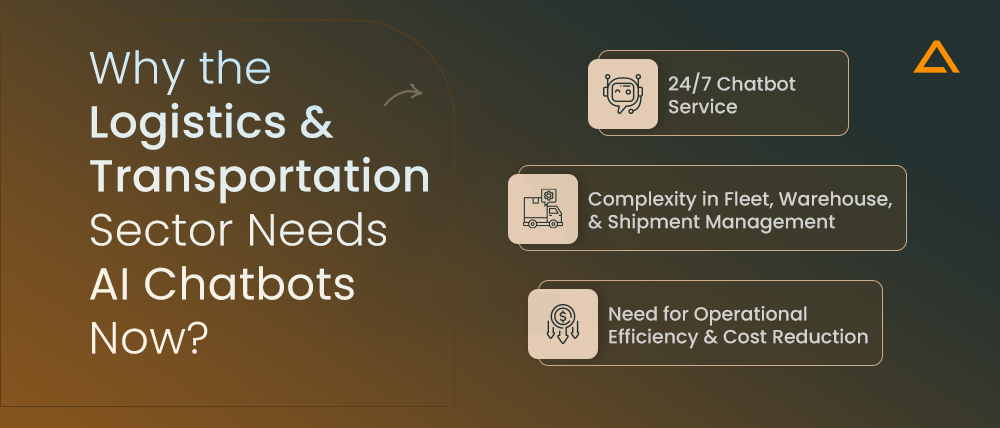
Rising Customer Expectations for Instant Updates and 24/7 Service
Today, customers expect to see real-time updates about their orders whether it’s a small package or a large freight shipment moving across countries.
If there’s a delay or missing information, trust can break quickly. And often, traditional customer service teams can’t respond fast enough to fix it.
That’s where AI-powered logistics Assistants come in.
By connecting directly to transportation management systems, warehouse databases, and even smart devices like IoT trackers, these chatbots can instantly fetch live updates and share them with customers anytime, across multiple platforms like websites, mobile apps, or messaging services.
This not only gives customers the quick answers they expect but also eases the workload on human support teams, allowing them to focus on solving more complex problems instead of handling basic status requests.
As 24/7 support becomes the new standard, AI chatbots offer the most efficient and scalable way for logistics companies to meet growing customer demands without driving up operational costs.
Complexity in Fleet, Warehouse, and Shipment Management
Managing a logistics operation today is like leading a busy team but instead of people with instruments, you’re coordinating trucks, warehouses, drivers, shipments, and vendors, all moving in different directions at different speeds.
And honestly, keeping everything working smoothly is getting harder, not easier.
Without fast, real-time communication, even small delays can quickly turn into major problems like causing missed deliveries, unhappy customers, and lost revenue.
This is where AI Assistants in transportation make a real difference.
They act like smart assistants between different systems and human teams, helping everyone stay connected and informed.
Need to check which trucks are available right now?
Want a quick update on inventory levels at a warehouse?
Need to reroute a shipment because of bad weather?
Instead of logging into multiple systems dashboards or making endless phone calls, planners and managers can simply ask a chatbot and get instant, accurate answers and sometimes even proactive suggestions powered by predictive analytics.
The result?
Less confusion, faster decisions, and a smarter operation that adjusts quickly to any challenge.
Need for Operational Efficiency and Cost Reduction
Margins in logistics are tight, so even small efficiency gains can really impact profits. But growing operations without raising costs is tough.
That’s where AI Assistants help, it handles routine tasks like booking, answering common questions, and helping drivers with smarter routes.
By linking these bots to backend systems, companies can spot issues early and keep things running smoothly all without needing more staff.
In short, it’s not just about doing things faster, but doing them smarter and scaling without the extra cost.
Core Benefits of Using AI Assistants in Logistics and Transportation
When it comes to logistics and transportation, speed, accuracy, and communication aren’t just “nice-to-haves” but they’re essentials.
AI-powered chatbots help companies stay ahead by automating everyday tasks, solving issues faster, and keeping supply chains running smoothly.
From drivers to warehouse teams to customers, everyone benefits from it and it’s making a real impact where it counts.

Real-Time Shipment Tracking and Updates
In logistics, knowing where a shipment is and when it will arrive is critical. Chatbots simplify this by connecting to tracking systems and providing live updates. This reduces the need for manual checks and enhances visibility across the supply chain.
Example:
- User: “Where is my shipment #98476?”
- Chatbot: “Your shipment #98476 is currently in transit and expected to arrive at the New Jersey distribution center by 4 PM today.”
Warehouse and Inventory Management Support
Managing inventory levels and product locations manually can be time-consuming. Assistants help warehouse staff quickly access stock information, low inventory alerts, and restocking timelines, keeping operations running smoothly.
Example:
- Staff: “How much inventory do we have for Product X?”
- Chatbot: “There are 435 units of Product X available in Warehouse 2.”
Fleet Management and Route Optimization
AI Assistants monitor fleet availability, analyze real-time traffic and weather data, and suggest the best routes. This helps dispatchers reduce delivery delays, improve fuel efficiency, and boost on-time performance.
Example:
- Dispatcher: “Show me available trucks for urgent delivery.”
- Chatbot: “Three trucks are currently available in Zone B. ETA at pickup: 20 minutes.”
Order Management and Last-Mile Delivery Assistance
Assistants help automate the order lifecycle from booking and confirmation to rescheduling or cancellations. They improve last-mile efficiency by offering real-time support to customers and delivery teams.
Example:
- Customer: “Can I reschedule my delivery to tomorrow afternoon?”
- Chatbot: “Sure! I’ve rescheduled your delivery to tomorrow between 2 PM and 4 PM.”
Customer Service 24/7 with Instant Resolutions
AI Assistants are always on and ready to answer queries, solve common issues, and guide users any time of day. They reduce the need for human intervention, especially during non-business hours.
Example:
- Customer: “How can I change my shipping address?”
- Chatbot: “You can update it under ‘My Orders’. Want me to send you the link?”
Multilingual and Omnichannel Engagement
Serving customers in their preferred language and platform (like WhatsApp, SMS, or app) improves accessibility. Multilingual Assistants ensure communication isn’t lost in translation.
Example:
- Customer (in Spanish): “¿Dónde está mi pedido?”
- Chatbot: “Su pedido está en tránsito y se entregará mañana.”
Feedback Collection & Sentiment Analysis
AI chatbots can collect post-delivery feedback and evaluate sentiment in real time. This helps companies proactively address customer dissatisfaction and improve service quality.
Example:
- Chatbot: “How was your recent delivery experience?”
- Customer: “It was delayed.”
- Chatbot: “I’m sorry to hear that. Would you like me to notify our support team?”
How AI Agents Power Logistics and Transportation Assistants?
AI agents go beyond simple chatbot interfaces. These autonomous or semi-autonomous systems make real-time decisions that keep logistics running at peak performance.
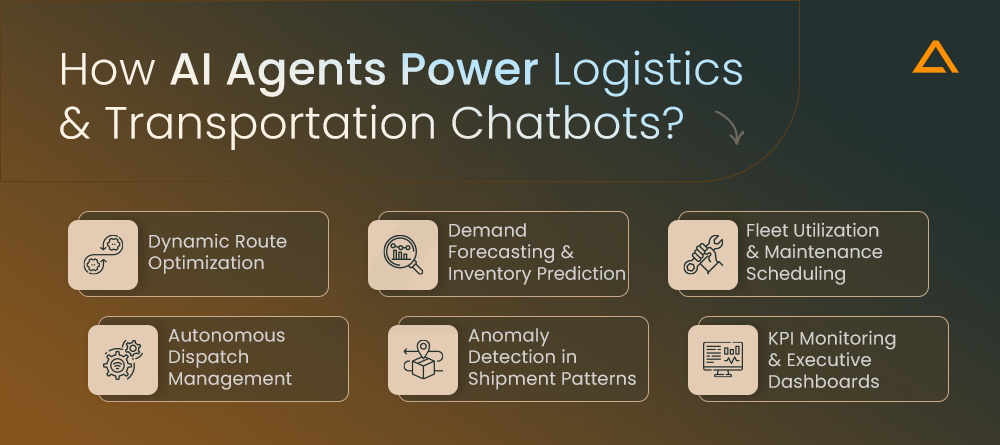
Dynamic Route Optimization
AI agents analyze real-time traffic conditions, weather updates, and vehicle health to determine the most efficient delivery routes. This helps reduce delays, fuel consumption, and costs, all while improving on-time deliveries.
Example:
- Planner: “What’s the fastest route for truck #21 today?”
- AI Agent: “Based on current traffic and weather, reroute through Route B. ETA improved by 17 minutes.”
Demand Forecasting & Inventory Prediction
Using past order data and external factors like market trends, AI agents forecast demand with high accuracy. This helps logistics teams better plan inventory, staffing, and fleet size ahead of time.
Example:
- Supervisor: “Do we need to stock more of Item A in Zone D?”
- AI Agent: “Yes. Expect a 40% surge in demand next week. Recommend replenishment.”
Fleet Utilization & Maintenance Scheduling
AI agents monitor vehicle performance using IoT data to schedule maintenance proactively. This avoids unexpected breakdowns and maximizes fleet utilization.
Example:
- Manager: “Any trucks due for servicing?”
- AI Agent: “Truck #14 shows early signs of engine wear. Recommend maintenance in 2 days.”
Autonomous Dispatch Management
AI assigns shipments to available drivers and trucks by analyzing load size, location, and deadlines result in speeding up the operations and improving dispatch accuracy.
Example:
- System: “Assigning driver Jhon to shipment #204. Closest match for load type and destination.”
Anomaly Detection in Shipment Patterns
AI agents monitor historical delivery data to flag anomalies like suspicious delays or unexpected scanning patterns, helping reduce losses and fraud.
Example:
- AI Agent: “Unusual delay and scan discrepancy detected for shipment #759. Recommend audit.”
KPI Monitoring & Executive Dashboards
Executives can access real-time dashboards built by AI agents that highlight delivery rates, operational efficiency, and cost metrics to guide decision-making.
Example:
- Exec: “What’s our average cost per mile this quarter?”
- AI Agent: “₹3.48/km, down 6% from last quarter. Breakdown available.”
Key Technologies Powering Logistics and Transportation Assistants
Behind every smart logistics chatbot that answers questions, tracks shipments, or coordinates fleet operations, there’s a combination of powerful technologies working quietly in the background.
These technologies make Assistants faster, more accurate, and capable of handling the real-world complexities of the supply chain.
Let’s break down the key technologies that enable AI Assistants in logistics to perform at a high level.
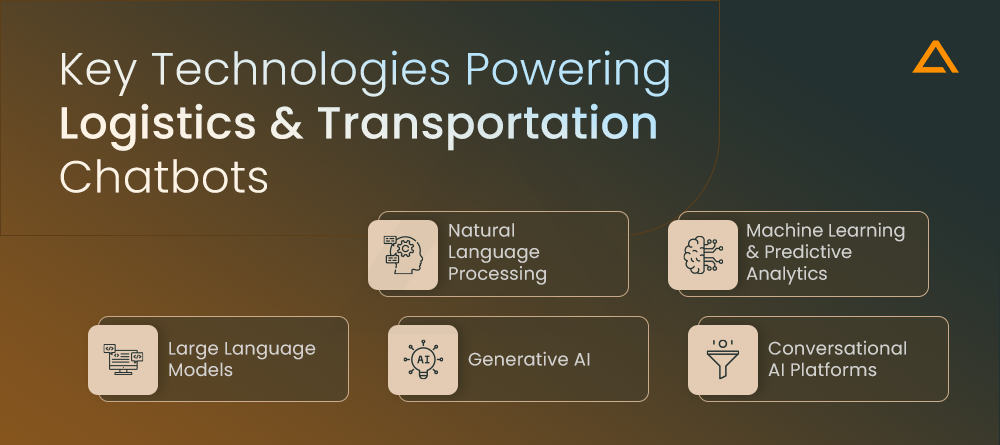
Natural Language Processing (NLP)
At the core of every intelligent Assistant is Natural Language Processing (NLP) the technology that allows machines to understand, interpret, and respond to human language.
In logistics, NLP makes it possible for Assistants to:
- Understand a customer asking, “Where is my package?” in different ways (“Track my order,” “Shipment status for 12345,” etc.)
- Handle slang, typos, or slightly incomplete queries
- Pull the right information from internal systems and present it in a human-friendly reply
Without NLP, Assistants would feel rigid and confusing.
With NLP, they sound more natural and helpful even when the questions aren’t perfectly phrased.
Machine Learning (ML) and Predictive Analytics
Machine Learning (ML) allows chatbots to get smarter over time.
In logistics and transportation, ML enables chatbots to:
- Learn from past conversations to answer questions more accurately
- Predict common shipment delays based on real-time factors like weather, traffic, or port congestion
- Recommend the best next action, like rerouting a delivery to avoid a bottleneck
Predictive analytics powered by ML turns Assistants from passive responders into proactive assistants spotting problems before they impact the supply chain.
Large Language Models (LLMs)
Large Language Models (LLMs) such as GPT-4, Claude, and others allow Assistants to understand more complex inputs and generate responses with higher accuracy and fluidity.
In logistics, LLMs enhance Assistants by:
- Understanding industry-specific language, terms, and customer context
- Holding longer, more context-rich conversations
- Interacting seamlessly across various query formats without needing rule-based scripting
LLMs power more intelligent and conversationally fluid logistics assistants that deliver more personalized and effective support.
Generative AI (GenAI)
Generative AI refers to the ability of machines to generate text, summaries, or documents based on context.
In logistics and transportation, GenAI enables:
- Automatic generation of personalized shipment updates or delay explanations
- Drafting of customs documentation or delivery reports
- Summarization of internal logistics reports or customer service transcripts
With GenAI, logistics chatbots not only answer questions but also help produce relevant content, improving both operational efficiency and the customer experience.
Conversational AI Platforms
Many advanced logistics chatbots are built using dedicated conversational AI platforms like:
- Google Dialogflow
- Microsoft Bot Framework
- Rasa
- IBM Watson Assistant
These platforms offer pre-trained language models, integration connectors, and customization options making it faster and safer to deploy smart chatbots without starting from scratch.
Companies can customize the behavior, tone, escalation rules (human handover), and system integrations to match their specific needs whether it’s last-mile delivery updates or international freight tracking.
Real-World Use Cases: AI Assistants in Logistics and Transportation
While AI Assistants are often discussed in theory, several major logistics companies have already deployed them and delivering real business results.
Here are genuine examples, with working sources.
DHL: Assistants for Customer Service and Internal Operations
DHL uses AI assistant to help customers track packages, get delivery times, and manage orders through its “DHL Parcel Chatbot” service.
This chatbot works via Facebook Messenger and the DHL website, providing 24/7 shipment tracking and basic customer support.
Their AI and digitalization push is well-documented in DHL’s logistics trend reports.
Emirates SkyCargo: SkyChain Digital Transformation
Emirates SkyCargo uses its SkyChain platform, which includes chatbot-style assistance for cargo bookings and tracking.
While they don’t brand it as a standalone “chatbot” product, the digital platform offers 24/7 digital interactions for tracking and booking shipments, removing a lot of manual work for freight customers.
Maersk: Using AI to Improve Customer Engagement
Maersk (global shipping and logistics giant) launched an AI-driven Assistants as part of their “Captain Peter” project, giving customers real-time shipping updates and cargo tracking with a conversational interface.
Captain Peter sends updates like temperature alerts, estimated delivery changes, and even proactive recommendations to customers.
Aramex: Scaling Multilingual Customer Service with AI Assistants
Aramex, a leading logistics company based in Dubai, has adopted AI Assistants to automate customer service operations globally.
The Assistants handle inquiries across live chat, email, and WhatsApp in four different languages, helping Aramex deliver faster responses, lower service costs, and improve customer satisfaction across their worldwide logistics network.
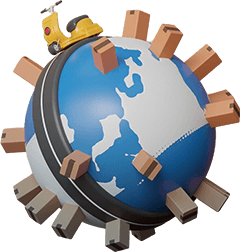
Searching for Logistics and Transportation IT Solutions?
Streamline logistics and fleet operations with our cutting-edge solution enhancing efficiency, reducing costs, and improving delivery workflows with speed and visibility.
How to Start Implementing AI Assistants in Logistics Step-by-Step
Seeing the benefits of AI Assistants is one thing.
Actually putting them into action in a way that fits your logistics operations takes careful planning.
The good news?
Getting started doesn’t have to be overwhelming.
By following a structured approach, logistics and transportation companies can roll out chatbots in a way that’s fast, manageable, and delivers real value from day one.
Here’s a simple step-by-step roadmap:
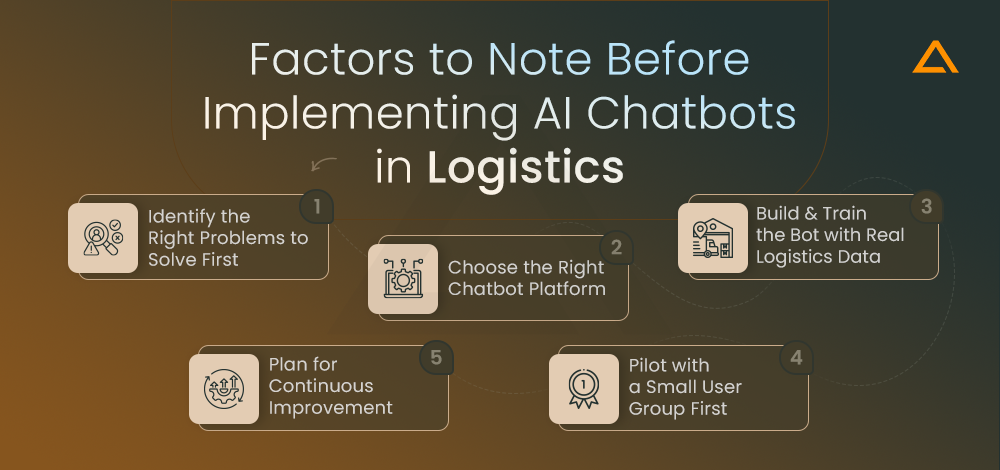
1. Identify the Right Problems to Solve First
Before building anything, start by asking:
- Where are we losing the most time today?
- What questions do our customer service teams answer again and again?
- Where are delays or information gaps causing issues?
Common starting points for logistics companies include shipment tracking inquiries, delivery rescheduling, warehouse stock updates, and order status requests.
Focus your first Assistants use case around one high-volume, repetitive problem not everything at once.
Small wins early on build momentum.
2. Choose the Right Assistant Platform
Not all chatbots are created equal.
For logistics needs, choose a conversational AI platform that can:
- Integrate easily with your Transportation Management System (TMS), Warehouse Management System (WMS), and CRM
- Handle multilingual communication
- Offer escalation options (human agent takeover when needed)
- Support channels like web, mobile app, WhatsApp, or SMS
Platforms like Google Dialogflow, Microsoft Bot Framework, and Rasa are common starting points for companies that need flexibility and control.
3. Build and Train the Bot with Real Logistics Data
A logistics Assistant is only as smart as the data behind it.
Make sure your chatbot connects to real shipment data, customer records, warehouse stock levels, and live tracking feeds not static FAQs or scripted flows.
Training the Assistant with real historical conversations (common customer questions, support logs) will help it understand the tone, language, and priorities specific to logistics operations.
4. Pilot with a Small User Group First
Before launching company-wide, start small:
- Select a department (like customer service for B2B clients)
- Pick a specific use case (like “Where’s my order?” inquiries)
- Roll out the chatbot to a controlled user group
Monitor how well the chatbot handles conversations, where it struggles, and where it succeeds.
Use real feedback to improve its responses before scaling wider.
5. Plan for Continuous Improvement
Launching an Assistant is not a one-time event, it’s the start of a continuous optimization journey.
Set up simple feedback mechanisms:
- Thumbs up/down after a response
- Surveys after completed chats
- Agent notes on escalated cases
Feed this data back into the chatbot’s training to make it smarter over time.
Future Trends of AI Assistant in Transportation and Logistics
As logistics companies continue to automate, digitize, and scale globally, the role of AI Assistants is only expected to grow. But these bots aren’t just staying as virtual assistants that answer basic questions and they’re evolving into proactive, intelligent collaborators that help reshape the way supply chains operate.
Here are the key trends that will shape the next generation of AI Assistants in logistics and transportation.
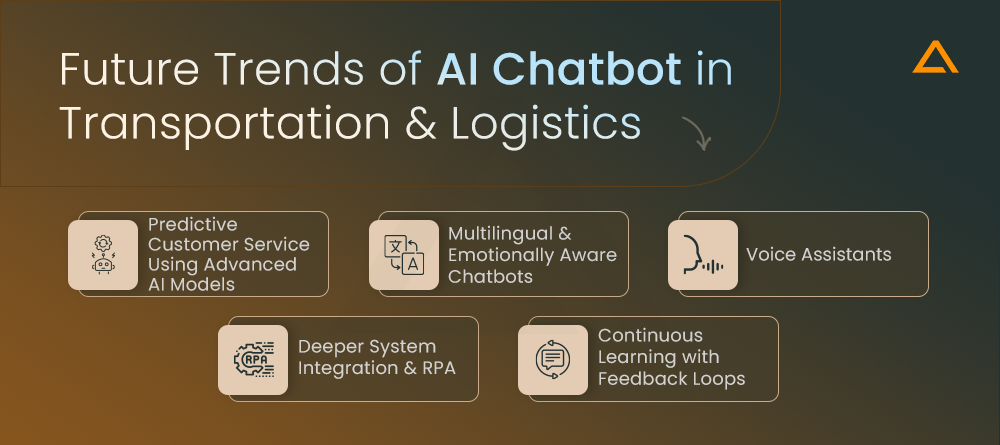
Predictive Customer Service Using Advanced AI Models
AI chatbots will move beyond reacting to customer questions, they’ll start anticipating them.
Using predictive analytics and real-time data from TMS and IoT devices, future bots will notify customers before issues happen:
“Your shipment may be delayed due to predicted port congestion. Would you like to reroute through an alternative hub?”
This level of proactive communication not only reduces inbound inquiries but builds real trust with customers something traditional support channels often struggle with.
Multilingual & Emotionally Aware Assistants
Global supply chains mean global customers. The next wave of chatbots will come with advanced multilingual capabilities not just translation, but local language nuance, regional slang, and tone matching.
Even more impressively, we’re starting to see chatbots equipped with sentiment analysis to detect frustration, urgency, or confusion. If a customer sounds upset, the bot can prioritize human handover or adjust its tone accordingly.
“I’m really sorry for the delay. Let me check how we can fix this for you quickly.”
This human-like interaction will become essential in providing a truly global and emotionally intelligent support experience.
Voice Assistants in the Warehouse and on the Road
Voice-enabled chatbots are already starting to support warehouse teams and drivers by providing hands-free access to information.
“Hey Bot, what’s the stock level of Product 218 in Warehouse 3?”
“You have 86 units available.”
Expect this to become more common especially in high-mobility environments where typing is inconvenient.
As voice recognition and natural language understanding improve, these assistants will enable smoother day-to-day operations on the ground.
Deeper System Integration & RPA (Robotic Process Automation)
The most powerful logistics bots of the future will be deeply connected to operational systems and not just CRM or TMS, but also ERP, order processing, and even RPA tools.
This will allow them to not just answer questions, but perform actions:
“Yes, your warehouse is out of stock. I’ve already triggered a reorder request through your ERP system.”
With these capabilities, chatbots move from support roles into active operational agents that save time and reduce manual work especially at scale.
Continuous Learning with Feedback Loops
Future Assistants won’t just get smarter from data they’ll also improve based on direct feedback.
Think: thumbs up/down on answers, human agent reviews, or automated training from unresolved queries.
This creates a closed learning loop, helping bots get better over time with minimal manual retraining.
The result? Higher accuracy, faster answers, and an Assistants experience that genuinely evolves with your operations.
This is called conversational RPA (Robotic Process Automation). It helps you get things done through simple conversations.
Why it matters: It saves time, reduces errors, and lets people focus on more important work.

Ready to bring your ideas to life with Generative AI?
You’re in the right place!
Conclusion
AI Assistants are no longer optional in logistics and transportation but they’re becoming essential tools for automation, real-time communication, and better customer service.
By starting small and focusing on key pain points, companies can unlock faster operations, smarter workflows, and higher customer satisfaction.
As logistics grows more complex, those who invest early in intelligent, scalable Assistant solutions will lead the next generation of supply chain excellence.
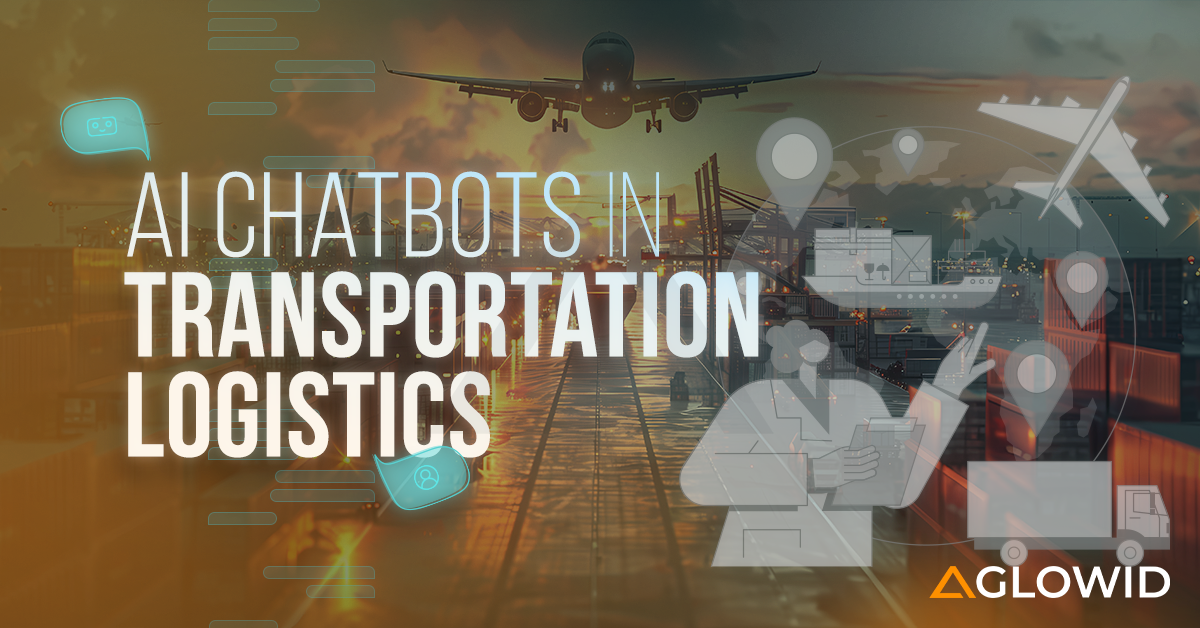

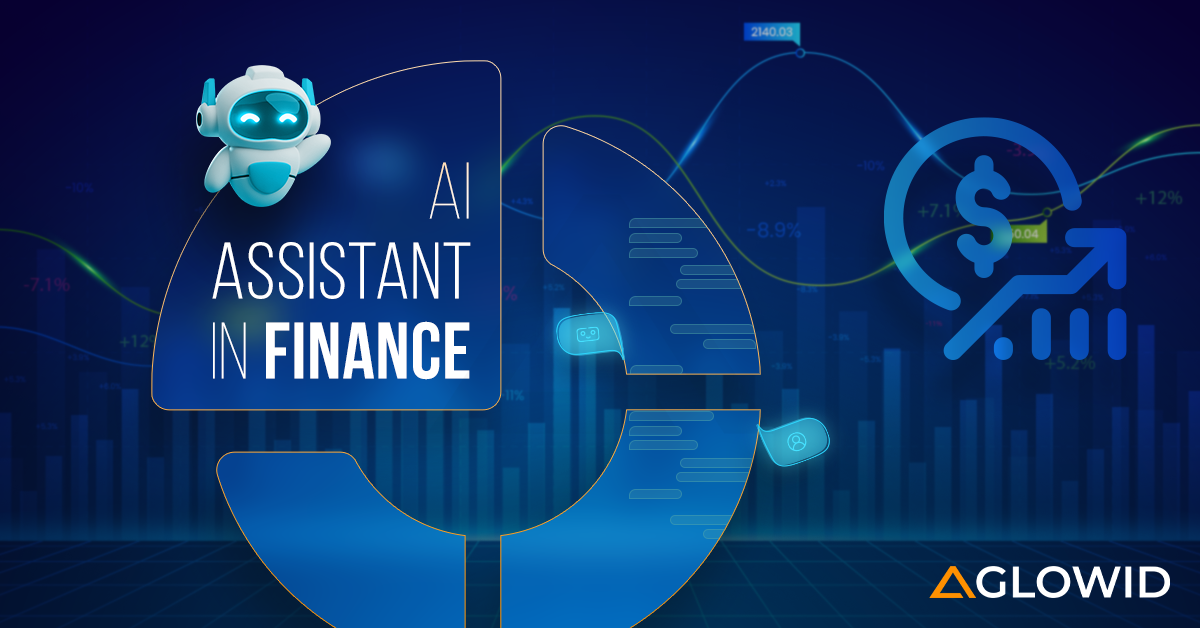
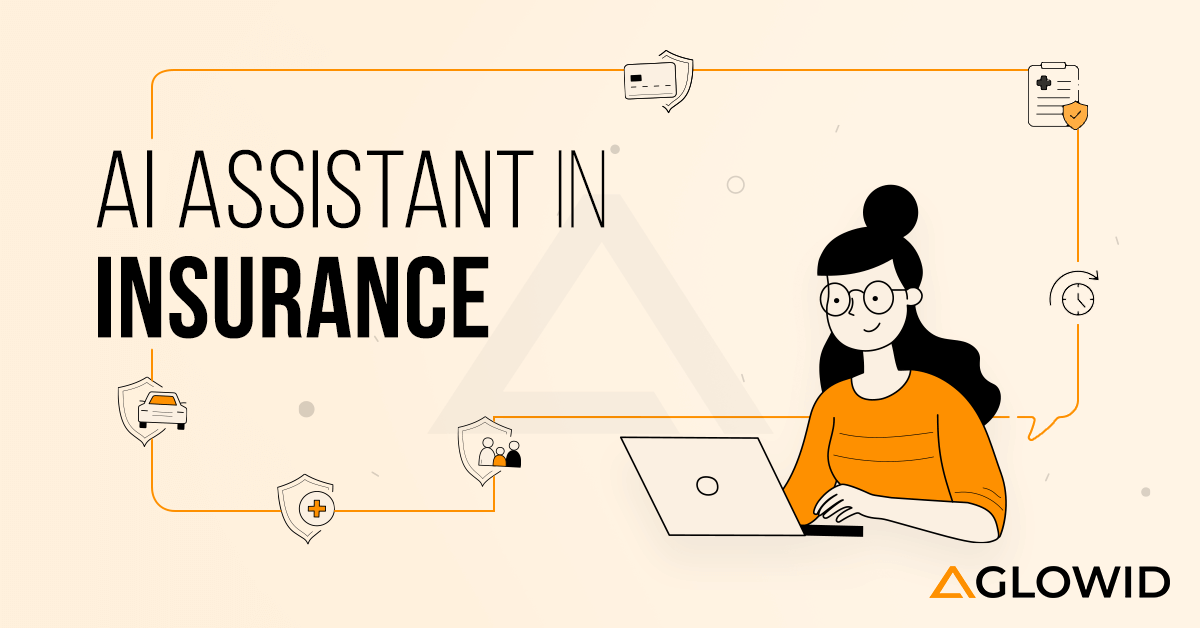

 Say
Say